service Acura Integra 2000 Hatchback Owner's Guide
[x] Cancel search | Manufacturer: ACURA, Model Year: 2000, Model line: Integra, Model: Acura Integra 2000Pages: 279, PDF Size: 3.57 MB
Page 241 of 279
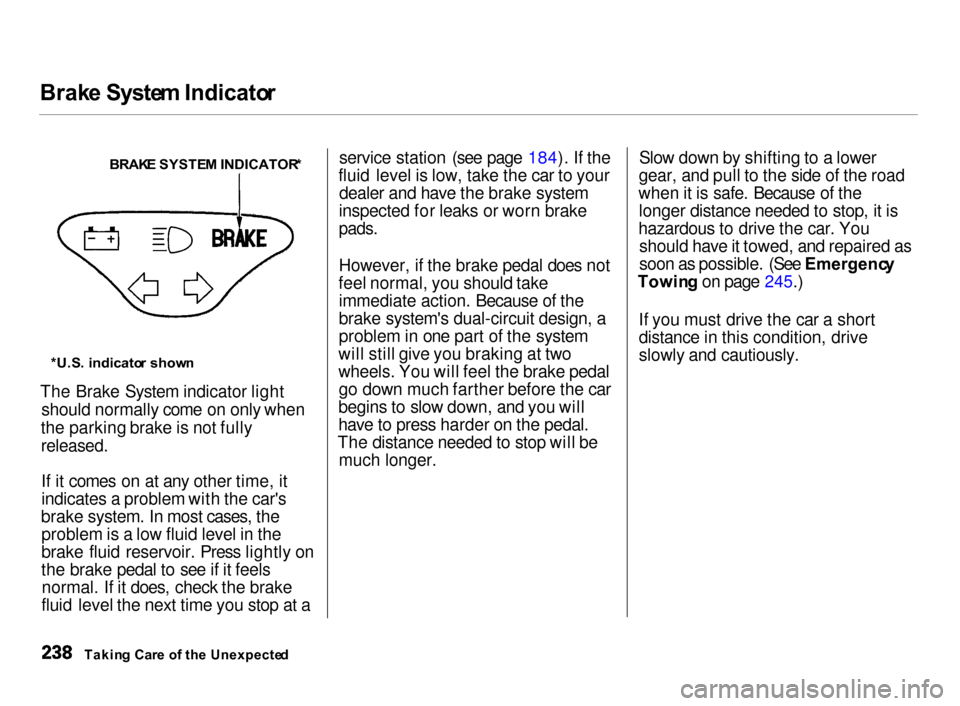
Brak
e Syste m Indicato r
The Brake System indicator light should normally come on only when
the parking brake is not fully
released.
If it comes on at any other time, it
indicates a problem with the car's
brake system. In most cases, the problem is a low fluid level in the
brake fluid reservoir. Press lightly on
the brake pedal to see if it feelsnormal. If it does, check the brake
fluid level the next time you stop at a service station (see page 184). If the
fluid level is low, take the car to your dealer and have the brake system
inspected for leaks or worn brake
pads.
However, if the brake pedal does not
feel normal, you should take immediate action. Because of the
brake system's dual-circuit design, a
problem in one part of the system
will still give you braking at two
wheels. You will feel the brake pedal go down much farther before the car
begins to slow down, and you will
have to press harder on the pedal.
The distance needed to stop will be much longer. Slow down by shifting to a lower
gear, and pull to the side of the road
when it is safe. Because of the longer distance needed to stop, it is
hazardous to drive the car. You should have it towed, and repaired as
soon as possible. (See Emergenc y
Towin g on page 245.)
If you must drive the car a short
distance in this condition, drive
slowly and cautiously.
Takin g Car e o f th e Unexpecte d
*U.S
. indicato r show n
BRAK
E SYSTE M INDICATOR *
Page 248 of 279
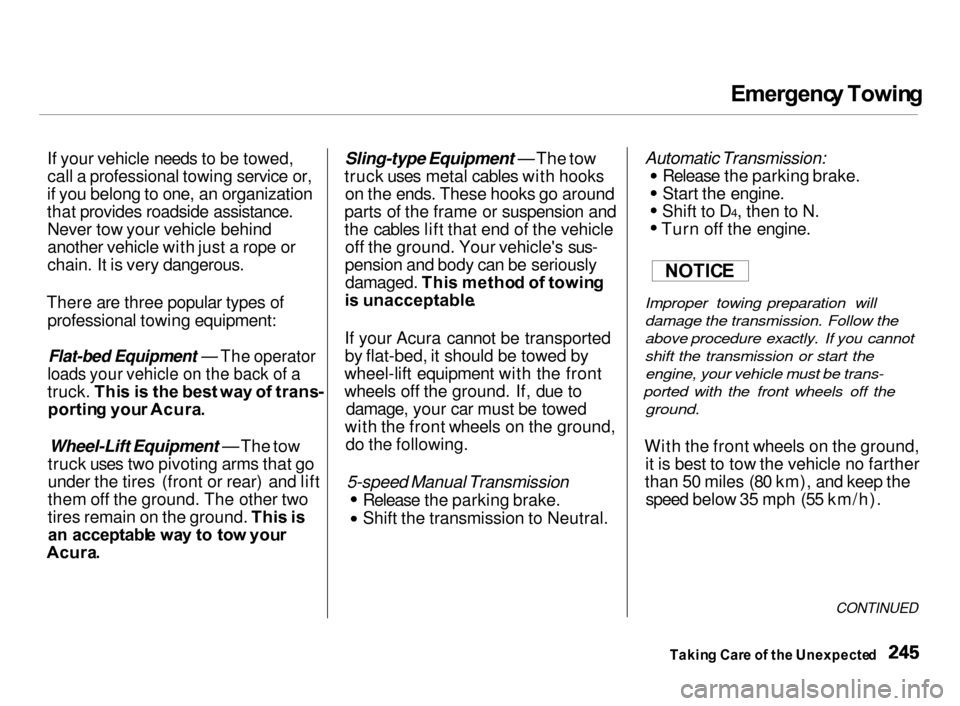
Emergenc
y Towin g
If your vehicle needs to be towed,
call a professional towing service or,
if you belong to one, an organization
that provides roadside assistance. Never tow your vehicle behind
another vehicle with just a rope or
chain. It is very dangerous.
There are three popular types of professional towing equipment:
Flat-bed Equipment — The operator
loads your vehicle on the back of a
truck. Thi s i s th e best way o f trans -
portin g you r Acura .
Wheel-Lift Equipment — The tow
truck uses two pivoting arms that go
under the tires (front or rear) and lift
them off the ground. The other two
tires remain on the ground. Thi s is
a n acceptabl e wa y t o to w you r
Acura .
Sling-type Equipment — The tow
truck uses metal cables with hooks on the ends. These hooks go around
parts of the frame or suspension and
the cables lift that end of the vehicle off the ground. Your vehicle's sus-
pension and body can be seriously damaged. Thi s metho d o f towin g
i s unacceptable .
If your Acura cannot be transported
by flat-bed, it should be towed by
wheel-lift equipment with the front
wheels off the ground. If, due to damage, your car must be towed
with the front wheels on the ground, do the following.
5-speed Manual Transmission
Release the parking brake.
Shift the transmission to Neutral.
Automatic Transmission:
Release the parking brake.
Start the engine.
Shift to D4, then to N.
Turn off the engine.
Improper towing preparation will
damage the transmission. Follow the
above procedure exactly. If you cannot
shift the transmission or start the engine, your vehicle must be trans-
ported with the front wheels off the
ground.
With the front wheels on the ground, it is best to tow the vehicle no farther
than 50 miles (80 km), and keep the speed below 35 mph (55 km/h).
CONTINUED
Takin g Car e o f th e Unexpecte d
NOTIC
E
Page 255 of 279
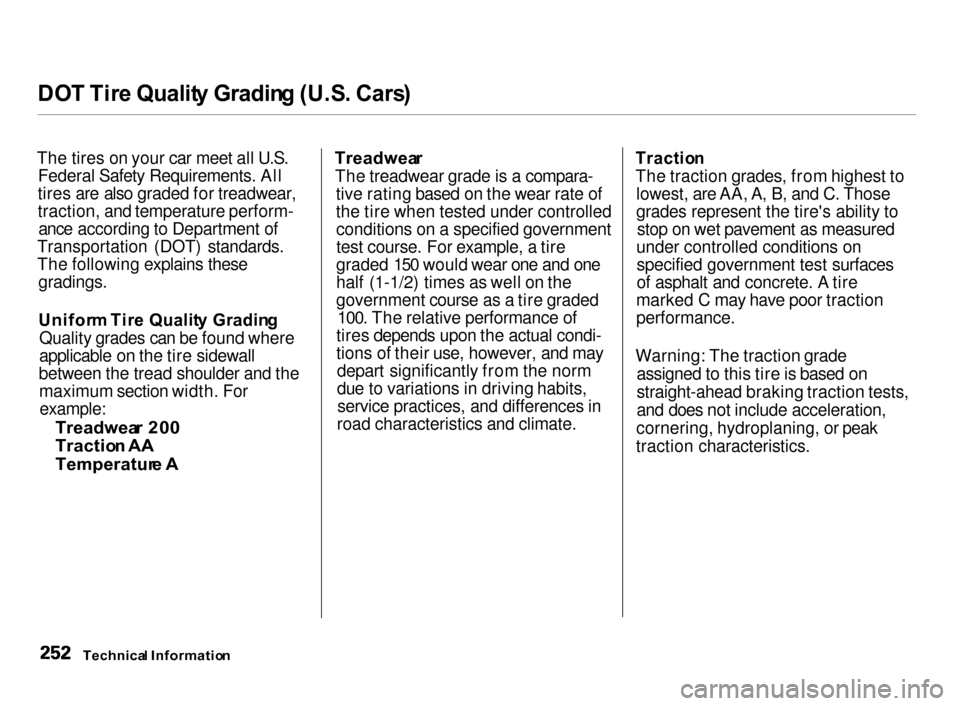
DO
T Tir e Qualit y Gradin g (U.S . Cars )
The tires on your car meet all U.S. Federal Safety Requirements. All
tires are also graded for treadwear,
traction, and temperature perform- ance according to Department of
Transportation (DOT) standards.
The following explains these gradings.
Unifor m Tir e Qualit y Gradin g
Quality grades can be found where
applicable on the tire sidewall
between the tread shoulder and the maximum section width. For
example:
Treadwea r 20 0
Tractio n A A
Temperatur e A
Treadwea
r
The treadwear grade is a compara- tive rating based on the wear rate of
the tire when tested under controlledconditions on a specified government
test course. For example, a tire
graded 150 would wear one and one
half (1-1/2) times as well on the
government course as a tire graded 100. The relative performance of
tires depends upon the actual condi-
tions of their use, however, and may depart significantly from the norm
due to variations in driving habits,service practices, and differences in
road characteristics and climate. Tractio
n
The traction grades, from highest to lowest, are AA, A, B, and C. Those
grades represent the tire's ability tostop on wet pavement as measured
under controlled conditions on specified government test surfaces
of asphalt and concrete. A tire
marked C may have poor traction
performance.
Warning: The traction grade assigned to this tire is based on
straight-ahead braking traction tests,
and does not include acceleration,
cornering, hydroplaning, or peak
traction characteristics.
Technica l Informatio n
Page 257 of 279
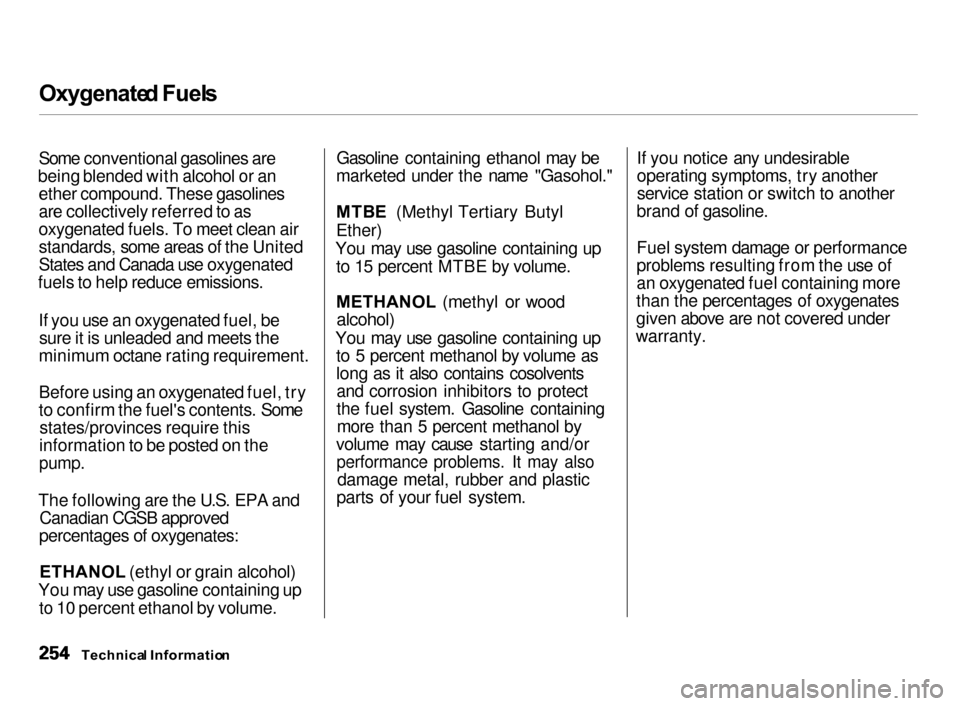
Oxygenate
d Fuel s
Some conventional gasolines are
being blended with alcohol or an ether compound. These gasolines
are collectively referred to as
oxygenated fuels. To meet clean air
standards, some areas of the United
States and Canada use oxygenated
fuels to help reduce emissions.
If you use an oxygenated fuel, besure it is unleaded and meets the
minimum octane rating requirement.
Before using an oxygenated fuel, try
to confirm the fuel's contents. Some states/provinces require this
information to be posted on the
pump.
The following are the U.S. EPA and Canadian CGSB approved
percentages of oxygenates:
ETHANOL (ethyl or grain alcohol)
You may use gasoline containing up to 10 percent ethanol by volume. Gasoline containing ethanol may be
marketed under the name "Gasohol."
MTB E (Methyl Tertiary Butyl
Ether)
You may use gasoline containing up to 15 percent MTBE by volume.
METHANOL (methyl or wood
alcohol)
You may use gasoline containing up to 5 percent methanol by volume as
long as it also contains cosolventsand corrosion inhibitors to protect
the fuel system. Gasoline containingmore than 5 percent methanol by
volume may cause starting and/orperformance problems. It may also
damage metal, rubber and plastic
parts of your fuel system. If you notice any undesirable
operating symptoms, try another
service station or switch to another
brand of gasoline.
Fuel system damage or performance
problems resulting from the use of
an oxygenated fuel containing more
than the percentages of oxygenates
given above are not covered under
warranty.
Technica l Informatio n
Page 263 of 279
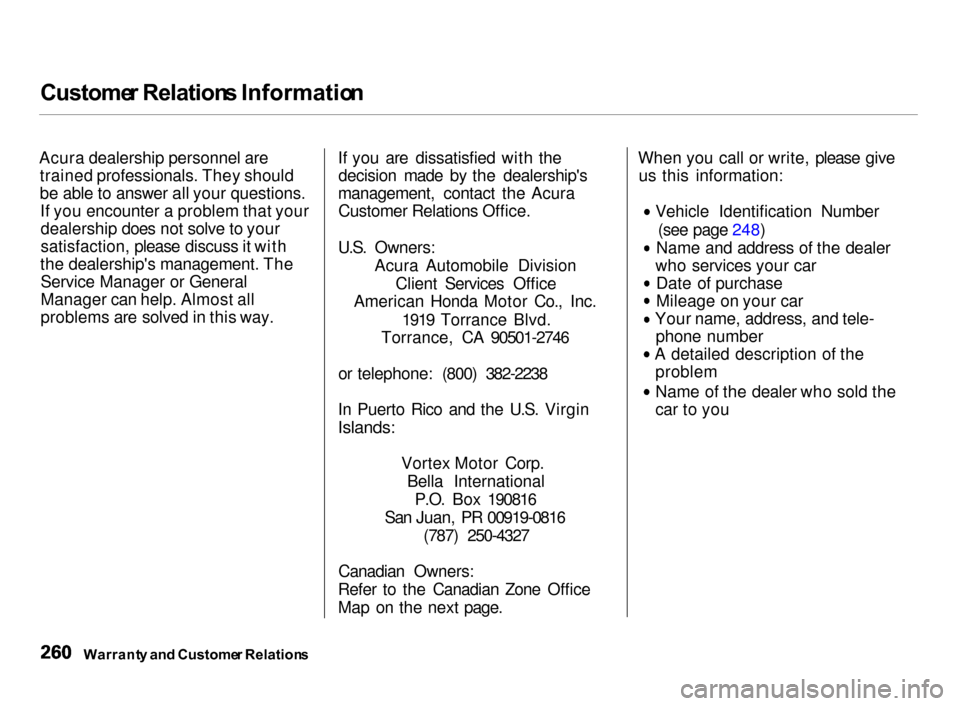
Custome
r Relation s Informatio n
Acura dealership personnel are trained professionals. They should
be able to answer all your questions.If you encounter a problem that yourdealership does not solve to your
satisfaction, please discuss it with
the dealership's management. The Service Manager or General
Manager can help. Almost all
problems are solved in this way. If you are dissatisfied with the
decision made by the dealership's
management, contact the Acura Customer Relations Office.
U.S. Owners: Acura Automobile DivisionClient Services Office
American Honda Motor Co., Inc.
1919 Torrance Blvd.
Torrance, CA 90501-2746
or telephone: (800) 382-2238
In Puerto Rico and the U.S. Virgin
Islands:
Vortex Motor Corp.Bella International P.O. Box 190816
San Juan, PR 00919-0816 (787) 250-4327
Canadian Owners:
Refer to the Canadian Zone Office
Map on the next page. When you call or write, please give
us this information: Vehicle Identification Number
(see page 248) Name and address of the dealer
who services your car Date of purchase
Mileage on your car
Your name, address, and tele-
phone number
A detailed description of the problem Name of the dealer who sold the
car to you
Warrant y an d Custome r Relation s
Page 269 of 279
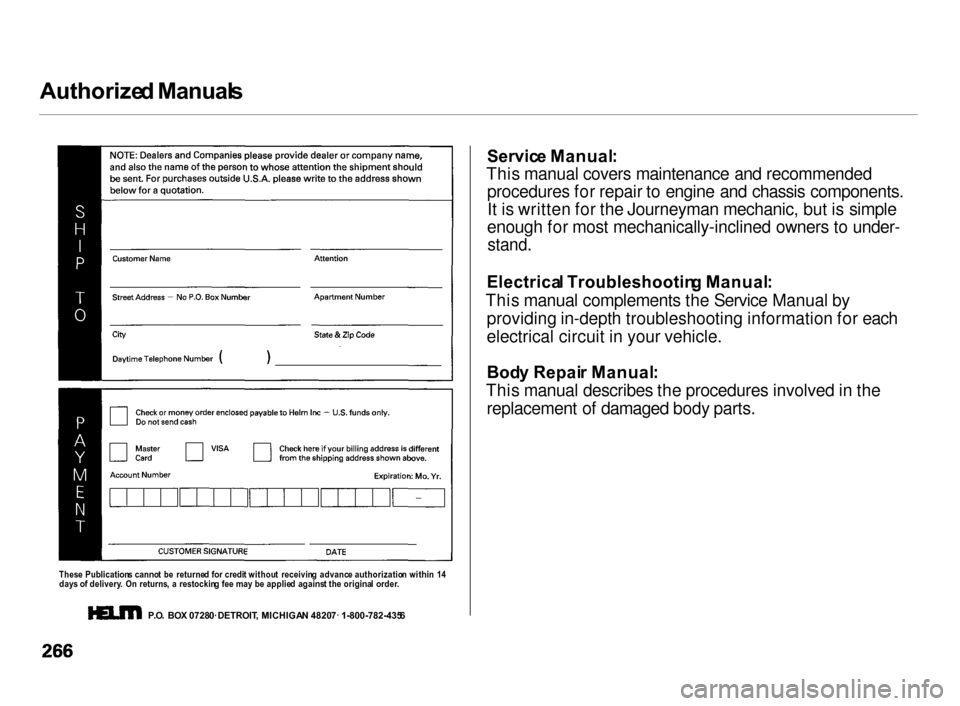
Authorize
d Manual s
Thes e Publication s canno t b e returne d fo r credi t withou t receivin g advanc e authorizatio n withi n 1 4
day s o f delivery . O n returns , a restockin g fe e ma y b e applie d agains t th e origina l order .
P.O
. BO X 0728 0 DETROIT , MICHIGA N 4820 7 1-800-782-435 6 Servic
e Manual :
This manual covers maintenance and recommended procedures for repair to engine and chassis components.It is written for the Journeyman mechanic, but is simple
enough for most mechanically-inclined owners to under-
stand.
Electrica l Troubleshootin g Manual :
This manual complements the Service Manual by providing in-depth troubleshooting information for each
electrical circuit in your vehicle.
Bod y Repai r Manual :
This manual describes the procedures involved in the replacement of damaged body parts.
Page 276 of 279
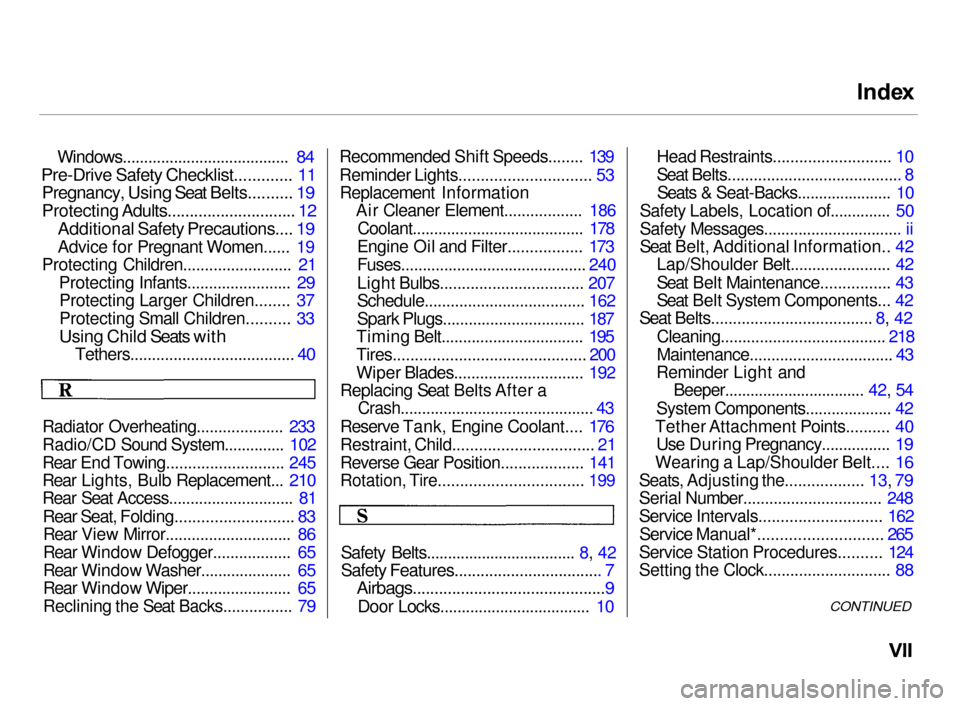
Inde
x
Windows....................................... 84
Pre-Drive Safety Checklist............. 11
Pregnancy, Using Seat Belts.......... 19
Protecting Adults............................. 12
Additional Safety Precautions.... 19
Advice for Pregnant Women...... 19
Protecting Children......................... 21
Protecting Infants........................ 29Protecting Larger Children........ 37
Protecting Small Children.......... 33
Using Child Seats with
Tethers...................................... 40
Radiator Overheating.................... 233
Radio/CD Sound System.............. 102
Rear End Towing........................... 245
Rear Lights, Bulb Replacement... 210
Rear Seat Access............................. 81
Rear Seat, Folding........................... 83
Rear View Mirror............................. 86
Rear Window Defogger.................. 65
Rear Window Washer..................... 65
Rear Window Wiper........................ 65
Reclining the Seat Backs................ 79 Recommended Shift Speeds........ 139
Reminder Lights.............................. 53
Replacement Information Air Cleaner Element.................. 186
Coolant........................................ 178
Engine Oil and Filter................. 173
Fuses........................................... 240
Light Bulbs................................. 207
Schedule..................................... 162
Spark Plugs................................. 187
Timing Belt................................. 195
Tires............................................ 200
Wiper Blades.............................. 192
Replacing Seat Belts After a
Crash............................................. 43
Reserve Tank, Engine Coolant.... 176
Restraint, Child................................ 21
Reverse Gear Position................... 141
Rotation, Tire................................. 199
Safety Belts................................... 8, 42
Safety Features.................................. 7
Airbags............................................9
Door Locks................................... 10 Head Restraints........................... 10
Seat Belts........................................ 8
Seats & Seat-Backs...................... 10
Safety Labels, Location of.............. 50
Safety Messages................................ ii
Seat Belt
, Additional Information.. 42
Lap/Shoulder Belt....................... 42
Seat Belt Maintenance................ 43
Seat Belt System Components... 42
Seat Belts..................................... 8, 42
Cleaning...................................... 218
Maintenance................................. 43
Reminder Light and
Beeper................................. 42, 54
System Components.................... 42
Tether Attachment Points.......... 40 Use During Pregnancy................ 19
Wearing a Lap/Shoulder Belt.... 16
Seats, Adjusting the.................. 13, 79
Serial Number................................ 248
Service Intervals............................ 162 Service Manual*............................ 265
Service Station Procedures.......... 124
Setting the Clock............................. 88
CONTINUED
Page 277 of 279
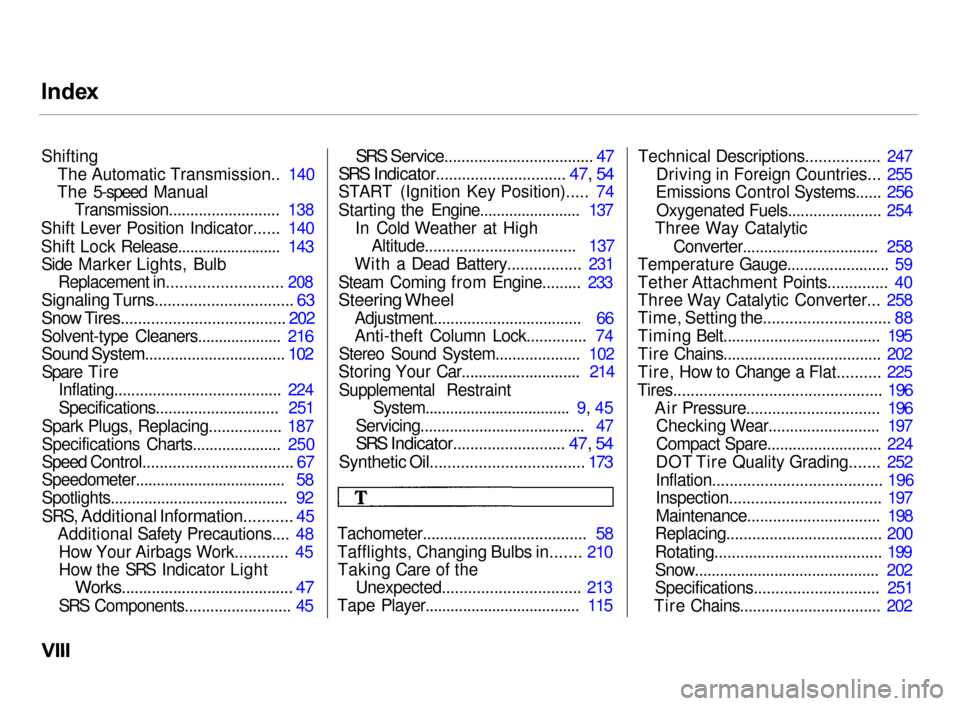
Inde
x
Shifting The Automatic Transmission.. 140
The 5-speed Manual Transmission.......................... 138
Shift Lever Position Indicator...... 140
Shift Lock Release......................... 143 Side Marker Lights, Bulb
Replacement in.......................... 208
Signaling Turns................................ 63
Snow Tires...................................... 202
Solvent-type Cleaners.................... 216
Sound System................................. 102
Spare Tire Inflating....................................... 224
Specifications............................. 251
Spark Plugs, Replacing................. 187
Specifications Charts..................... 250
Speed Control................................... 67
Speedometer.................................... 58
Spotlights.......................................... 92
SRS, Additional Information........... 45
Additional Safety Precautions.... 48
How Your Airbags Work............ 45
How the SRS Indicator Light
Works........................................ 47
SRS Components......................... 45
SRS Service................................... 47
SRS Indicator.............................. 47, 54
START (Ignition Key Position)..... 74
Starting the Engine........................ 137
In Cold Weather at HighAltitude................................... 137
With a Dead Battery................. 231
Steam Coming from Engine......... 233
Steering Wheel
Adjustment................................... 66
Anti-theft Column Lock.............. 74
Stereo Sound System.................... 102
Storing Your Car............................ 214
Supplemental Restraint System...................................
9, 45
Servicing....................................... 47
SRS Indicator.......................... 47, 54
Synthetic Oil................................... 173
Tachometer...................................... 58
Tafflights, Changing Bulbs in....... 210 Taking Care of the Unexpected................................ 213
Tape Player..................................... 115 Technical Descriptions................. 247
Driving in Foreign Countries... 255
Emissions Control Systems...... 256
Oxygenated Fuels...................... 254
Three Way Catalytic
Converter................................ 258
Temperature Gauge........................ 59
Tether Attachment Points.............. 40
Three Way Catalytic Converter... 258
Time, Setting the............................. 88
Timing Belt..................................... 195
Tire Chains..................................... 202
Tire, How to Change a Flat.......... 225
Tires................................................ 196 Air Pressure............................... 196Checking Wear.......................... 197
Compact Spare........................... 224
DOT Tire Quality Grading....... 252
Inflation....................................... 196
Inspection................................... 197
Maintenance............................... 198
Replacing.................................... 200
Rotating....................................... 199
Snow............................................ 202
Specifications............................. 251
Tire Chains................................. 202
Page 279 of 279
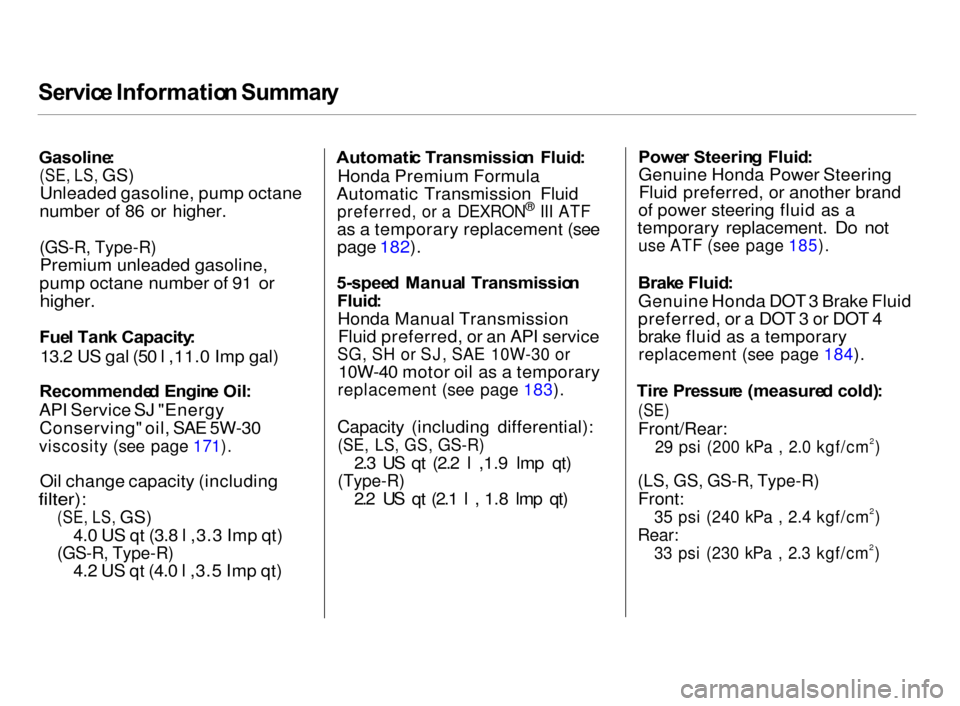
Servic
e Informatio n Summar y
Gasoline :
(SE,
LS,
GS) Unleaded gasoline, pump octane
number of 86 or higher.
(GS-R, Type-R)
Premium unleaded gasoline,
pump octane number of 91 or
higher.
Fue l Tan k Capacity :
13.2 US gal (50 l ,11.0 Imp gal)
Recommende d Engin e Oil :
API Service SJ "Energy Conserving" oil, SAE 5W-30
viscosity (see page 171).
Oil change capacity (including
filter):
(SE,
LS,
GS)4.0 US qt (3.8 l ,3.3 Imp qt)
(GS-R, Type-R)
4.2 US qt (4.0 l ,3.5 Imp qt) Automati
c Transmissio n Fluid :
Honda Premium Formula
Automatic Transmission Fluid
preferred, or a DEXRON ®
III ATF
as a temporary replacement (see page 182).
5-spee d Manua l Transmissio n
Fluid :
Honda Manual Transmission Fluid preferred, or an API service
SG, SH or SJ, SAE 10W-30 or
10W-40 motor oil as a temporary
replacement (see page 183).
Capacity (including differential):
(SE,
LS,
GS,
GS-R)
2.3 US qt (2.2 l ,1.9 lmp qt)
(Type-R)
2.2 US qt (2.1 l , 1.8 lmp qt) Powe
r Steerin g Fluid :
Genuine Honda Power Steering Fluid preferred, or another brand
of power steering fluid as a
temporary replacement. Do not
use ATF (see page 185).
Brak e Fluid :
Genuine Honda DOT 3 Brake Fluid
preferred, or a DOT 3 or DOT 4 brake fluid as a temporary
replacement (see page 184).
Tir e Pressur e (measure d cold) :
(SE)
Front/Rear:
29 psi (200 kPa , 2.0 kgf/cm2)
(LS, GS, GS-R, Type-R)
Front:
35 psi (240 kPa , 2.4 kgf/cm2)
Rear:
33 psi (230 kPa , 2.3 kgf/cm2)